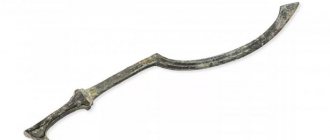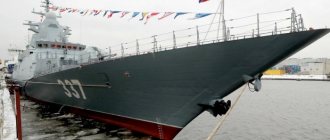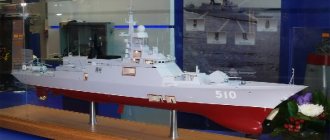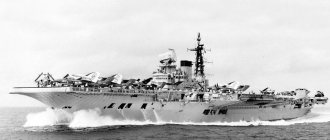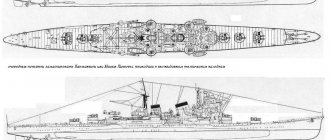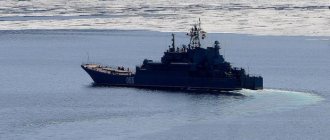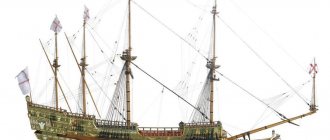With the advent of the first sufficiently stable and reliable watercraft, battles began to be carried out not only on land, but also on water. And the one whose ships moved faster and were better equipped won here. Even before the advent of our era, large numbers of military ships plied the waters of the Mediterranean and the South China Sea, which were significantly different in design from merchant ships. In this article we will talk about several types of warships of the ancient world, references to which are contained in historical documents.
Nimitz class aircraft carriers (USA)
The concept of a “super carrier” originated in the United States back in the 1950s, and the first such ship appeared in 1968. The length of the vessel is more than 330 meters, which is partly due to the size of the takeoff and landing zone for aircraft. The aircraft carrier is capable of speeds of up to 30 knots, which is possible thanks to two nuclear reactors. The vessel hosts an impressive air group consisting of 90 aircraft representatives.
"The fastest destroyers"
1st place "Le Terrible"
The destroyer was originally from France and reached a speed of 45 knots.
It was the same as that of the Italian Navigatori, but when measured in kilometers per hour, the Frenchman was faster and it was he who got into the Guinness Book of Records. Le Terrible showed its maximum speed in 1935, and its displacement was 800 tons more than that of its Italian competitor and amounted to 3251 tons. It was driven by four steam boilers, as well as two turbines. As a result, producing a power of 100 thousand horsepower. At the beginning of the 20th century, many engineers began to design "leaders", a type of destroyer that had outstanding speed. For this reason, they occupy all 3 places in the list of fast movers. You cannot find any active destroyer here.
2nd place “Navigatori”
The Navigatori type was originally from Italy and 12 of these ships were built. Back then they were called not “leaders”, but “scouts”. They were born from 1929 to 1931, at the same time as the previously described destroyer from England. The displacement of the Navigatori was only 2,400 tons, but the speed was developed to 45 knots. The ship encountered shell scattering and despite the fact that it was not classified as a failed project, it did not even survive until World War II and in 1938 the entire type of equipment was decommissioned.
3rd place "HMS Codrington"
This list is opened by a representative of the British Navy. It would be naive to believe that no island nation was building some of the best ships, since it was by World War II that England and Germany were the main participants in water battles. So it was built in 1929, 10 years before the biggest war of our time. It was extremely fast, but not very maneuverable; its speed at that time was 40 knots. But the production of this vessel can well be called a failure, because the construction price tag was very high, and even light cruisers could more easily endure the difficulties imposed on it.
Battleship HMS Dreadnought (“Neustrashimy”, UK)
In October 1906, a battleship was introduced into service with the Royal British Navy, which immediately surpassed its brothers in functionality. The main feature was the composition of its artillery. It did not have medium-caliber guns, which made it possible to increase the number of 305-mm guns to 10. This gave the ship a fire advantage over any opponent.
Türkiye
The Turkish fleet is one of the oldest in the world. It dates back to the 11th century. However, modern history begins with the first half of the 20th century. The Turkish Navy played an important role in military battles for part of Cyprus. At this moment, landing ships, with fire support from the sea, landed soldiers on the island and divided the territory into 2 parts. Today, Turkey represents a balanced strike force seeking to maintain order in the eastern Mediterranean and southern Black Seas. As a member of NATO, the Turkish government can afford not to develop its own naval power to the level of world leaders, while the country feels confident and protected.
Aircraft carrier "Admiral Kuznetsov" (USSR/Russia)
"Admiral Kuznetsov" was introduced into the USSR fleet less than a year before its collapse. Although it is a very large warship, its standard displacement is half that of the Nimitz. But “Kuznetsov” is designed to work with nuclear submarines with nuclear missiles on board.
List of the best warships in the world
It is hardly possible to make an absolutely objective top list of the most powerful ships in history. Even such a seemingly unambiguous criterion as displacement is not always applicable for compiling a rating. It is clear that any cruiser in this regard will be inferior to an aircraft carrier or battleship, but it is quite obvious that the Dreadnought, for example, will not survive in a battle with Peter the Great - it will simply not be allowed within salvo range. Therefore, it makes sense to list the ships, focusing not on power or size, but on the contribution they made to the development of the navy.
Nimitz class aircraft carriers (USA)
The concept of a “supercarrier” arose in the United States back in the 50s of the last century. The first such ship appeared in 1961. It was a CVN-65 Enterprize that served in the US Navy until 2012. Due to a number of reasons, this project did not receive further development. Instead, starting in 1968, construction began on even larger super-aircraft carriers of the Nimitz class (named after the lead ship of the series).
American aircraft carrier Nimitz
The length of these ships exceeds 330 meters, which is partly due to the size of the runway for aircraft. The normal displacement is 97 thousand tons, and the total displacement is over one hundred and four thousand tons. The huge ship is capable of moving at a speed of 30 knots (55.6 km/h) with the help of two nuclear reactors developing up to 260,000 horsepower.
The main task of Nimitz-class aircraft carriers is to “project US power” in various regions of the world. For this purpose, an impressive air force is placed on board, numbering up to 90 different aircraft and helicopters. Although there have been some doubts in recent years as to whether the world's largest warships are truly that efficient, the Nimitz is undoubtedly a true technical masterpiece, the pinnacle of the evolution of shipbuilding.
Battleship HMS Dreadnought (“Neustrashimy”, UK)
On October 3, 1906, a battleship was introduced into the Royal Navy of Great Britain, which instantly made all battleships of that time obsolete. The new battleship was called Dreadnought, which translates as “Fearless.” He inherited this name from his five “predecessors”, but it was he who managed to make the word “dreadnought” a common noun.
British battleship HMS Dreadnought
The main feature of the Neustrashimy was the artillery composition - it did not have intermediate-caliber guns, which made it possible to increase the number of powerful 305-mm guns to ten, providing the ship with fire superiority over any opponent. In addition, the Dreadnought moved at a record speed of 21 knots at that time, since it had the latest type of power plant with steam turbines.
The creation of this ship led to the hasty rearmament of not only the British, but also all other navies - sailors everywhere sought to get their own “dreadnoughts”. Their armament and speed increased so quickly that at the beginning of the First World War, HMS Dreadnought itself became obsolete, and after its completion it was scrapped. Nevertheless, he left his mark on the history of shipbuilding.
Aircraft-carrying cruiser "Admiral Kuznetsov" (USSR/Russia)
The only Russian aircraft carrier, Admiral Kuznetsov, was commissioned into the Soviet Navy less than a year before the collapse of the USSR. Although this is a very large warship by all standards, its standard displacement is approximately half that of the American Nimitz - about 46 thousand tons. However, Kuznetsov was not created to “project force”, but to support the operations of nuclear submarines with nuclear missiles on board.
Russian aircraft carrier Admiral Kuznetsov
The basis of this ship's aviation group is the Su-30 and MiG-29K fighters. In addition, it is possible to use a “marine” version of the Su-25 attack aircraft. The Admiral Kuznetsov is currently undergoing repairs, and there is a possibility that it will eventually be decommissioned, as has already happened with some other ships.
Project 941 submarine "Akula" (USSR/Russia)
If Soviet aircraft-carrying cruisers could not compete in size with their overseas “colleagues,” then in the field of submarine construction the situation was exactly the opposite - it was the USSR that created the largest nuclear submarine in world history. Its displacement reaches 48,000 tons with a length of 172 meters.
Such a significant value is due not to the desire for a “record” or gigantomania, but to the need to place on board twenty intercontinental ballistic missiles with ten nuclear warheads each. Submarines armed with this arsenal were built according to Project 941 (code “Shark”). In the USA, these submarines were designated as Typhoon (that is, “Typhoon”).
Project 941 nuclear submarine (“Shark”)
The “Shark” attracts attention not only for its size, but also for its unusual design - it has two durable hulls connected to each other by several passages and a block for accommodating missiles. This entire “catamaran” is enclosed in a common lightweight body. The huge size of the submarine made it possible to provide very good service conditions for the crew. It is noteworthy that with such an impressive size, the “Shark” is quite quiet and extremely difficult to detect.
Cruiser "Peter the Great" (Russia)
Among all the surface warships in the world that are not aircraft carriers, the largest is the modern heavy missile cruiser "Peter the Great". Its standard displacement reaches 23,750 tons with a length of 250 meters. On board this ship there are two nuclear reactors, developing a total of up to 140 thousand horsepower.
Nuclear-powered missile cruiser "Peter the Great"
The main purpose of the Peter the Great is to destroy enemy aircraft carrier groups. The “main caliber” of the cruiser are supersonic cruise missiles “Granit” (20 pieces). They can be equipped with both conventional and nuclear warheads. The largest nuclear-powered cruiser in the world is reliably protected from attacks from the air and from under water, it has very diverse and effective weapons, allowing it to intercept torpedoes and anti-ship missiles, and destroy enemy submarines and aircraft.
Sailing battleship Santisima Trinidad ("Holy Trinity", Spain)
The Spanish sailing battleship Santisima Trinidad, built in 1769, had a record displacement for its time of 4902 tons and a length of 61.3 meters. But it did not immediately become the most powerful ship in the world, but only after modernization in 1795, when a fourth gun deck appeared on it. This made it possible to increase the number of guns to 144.
Painting depicting the Spanish sailing battleship Santisima Trinidad
The Spanish sailors, however, were not enthusiastic about this battleship, since it became heavy and clumsy, and an upward shift in the center of gravity could potentially cause the ship to capsize.
The two most famous episodes of the use of the “Holy Trinity” were the Battle of St. Vincent and the Battle of Trafalgar. In the first case, the battleship repelled the attacks of seven English ships, and in the second, luck was not on its side - the Santisima-Trinidad was captured and after some time it was scuttled. Unfortunately, it was not possible to find the wreckage of this ship of considerable historical value.
Battleship "Bismarck" (Germany)
After the end of the First World War, German shipbuilders for a long time did not produce large warships, but after Hitler came to power, this situation could not help but change. In 1936, the laying of a new battleship, later named Bismarck, took place at the Hamburg shipyards. At first it was created as a reinforced heavy cruiser, intended for independent operations against trade communications, but after a few months the project was revised in the direction of making the ship larger and stronger.
German battleship Bismarck
Bismarck began service already during the Second World War, on August 24, 1940. With a standard displacement of about 41.7 thousand tons and a length of 242 meters, it became the largest warship in the world. True, by this time the much larger Yamato had already been launched, but it was introduced into the Japanese fleet only at the end of 1941.
In a duel, the Bismarck could beat any American or English ship with the help of its eight 380-mm main caliber guns, which was confirmed during the first and last combat campaign of the German battleship.
On May 24, 1941, the Bismarck, acting in conjunction with the heavy cruiser Prinz Eugen, sank the English battlecruiser Hood during a short battle in the Denmark Strait and forced the battleship Prince of Wales to retreat.
The damage received during this battle forced the Bismarck commander to turn back, but he did not return to base: the British gathered enormous forces against the German ship - three battleships, two heavy cruisers, three destroyers and one aircraft carrier. The latter’s participation was decisive - a torpedo bomber rising from its deck with a successful hit disabled the Bismarck’s steering.
As a result, the British managed to catch up and destroy the battleship. Being under severe fire, this ship demonstrated amazing survivability, but this only delayed the inevitable ending - at about half past 11 am on May 27, 1941, the giant went under water along with the vast majority of the crew members.
Iowa class battleships (USA)
American battleship Iowa, turned into a museum ship
Although American shipbuilders thought about creating new battleships of increased size back in the 30s, the construction of such ships began only in 1940 - apparently, not without the influence of reports about the appearance of the Bismarck and "Yamato." The first battleship of the new series, Iowa, was put into operation only at the end of February 1943, but it managed to take part in the war in the Pacific Ocean. A total of 4 ships of this class were subsequently built.
The total displacement of the Iowa was 58 thousand tons with a length of 270 meters. Initially, the main weapons of this battleship were nine 406 mm guns. As American naval warfare tactics changed significantly in 1941–42, the ship was used primarily in support of aircraft carriers.
The post-war fate of the Iowa-class battleships turned out to be bizarre - they were twice withdrawn from the fleet and then returned to service. In the 1980s, ships were armed with Tomahawk missiles and were used to carry out a number of operations in the Persian Gulf. The last of the battleships of this class, Wisconsin, served in the US Navy until 2006.
Battleship Yamato (Japan)
The largest battleship ever built was built in Japan. It was the Yamato - a giant with a total displacement of almost 73 thousand tons and a length of 263 meters. This ship, in addition, had the most powerful main caliber artillery - it consisted of nine 460 mm guns. The Yamato, of course, represented an outstanding technical achievement, but at the same time it became clear evidence of the decline of the short era of “super-dreadnoughts” - the future no longer belonged to them.
Explosion of the battleship Yamato. The height of the resulting “mushroom” reached five kilometers
For most of the war, this ship was at the base, earning the nickname “the biggest and most useless thing in the world” from Japanese sailors. The only operation in which the Yamato could achieve major success was the battle in Leyte Gulf, but due to the indecisive actions of the commander of the Japanese formation, this did not happen.
On April 6, 1945, Yamato put to sea to attack American supply ships. No one believed in the success of this operation from the very beginning, which was confirmed the next day - the ship was discovered and attacked from the air. After being hit by ten torpedoes and thirteen bombs, the battleship lost speed and tilted. An explosion soon followed - the main caliber shells detonated and the huge ship disappeared under water.
MDKVP "Zubr" (USSR/Russia)
In 1988, a new type of landing ship appeared in the Soviet navy - Project 12322 Zubr MDKVP. This complex acronym stands for “small landing hovercraft.”
Despite the presence of the word “small” in the full designation, “Bison” became the world’s largest military hovercraft for landing troops. The main advantage of this ship is its ability to move with ease both by sea and on land. The "Bison" can overcome trenches, drive over mines without causing their detonation, and also move freely through the swamp.
MDKVP "Zubr" in the port
Worldwide, only 30% of the total length of the sea coast is inaccessible to this ship. In all other cases, the landing force will be delivered to its destination, and in a short time - the Zubr is very fast, it reaches a speed of up to 60 knots (more than 111 km/h).
The nominal capacity of the ship is 366 people and 10 armored personnel carriers. Instead of armored personnel carriers, you can take on board three tanks or 8 infantry fighting vehicles. In addition, the Zubr is not just a vehicle, it is armed. The landing can be supported by fire from installations for launching 140-mm rockets, and protection from air attacks is provided by two ship-based AK-630 assault rifles with six-barreled automatic cannons of 30 mm caliber.
Project 941 submarine "Akula" (USSR/Russia)
Soviet aircraft cruisers could not compare in size with foreign equipment. However, in the field of underwater shipbuilding, everything was the other way around. The Union created a nuclear submarine with the largest dimensions in world history. Its displacement is 48,000 tons and its length reaches 172 meters. Such a large number was due to the need to carry twenty intercontinental ballistic missiles.
Type 055 destroyers
Type 055 destroyers are Chinese ships whose construction began back in 2014. An extension of the 052 class, these ships are larger and more capable than any other ship of their class, and are likely to provide stiff competition to the Ticonderoga class cruisers.
Type 055 ships are 180 meters long, making them longer than the Ticonderoga, and weigh approximately over ten thousand tons. Like their American counterparts, the Type 055 destroyers are likely designed to serve as bodyguards to China's carrier fleet, with the ability to take on submarines and ships if necessary.
One feature that makes the Type 055 on this list: a total of 112 vertical launch silos, each of which can carry YJ-18A and YJ-100 anti-ship cruise missiles, land attack cruise missiles, or HQ-9B long-range air defense missiles. These ships also use short-range HHQ-10 surface-to-air missiles, similar to the NATO Rolling Body Missile (RIM-116), and H/PJ-11 close-in combat systems, similar to the US Mark 15 Phalanx CIWS.
China launched two Type 055 ships simultaneously in July 2018, with a total of six ships in varying states of completion. China is believed to be planning to build eight destroyers.
Bismarck-class battleship (Germany)
After the end of the First World War, shipbuilders in Germany were reluctant to build large warships for a long time. However, the situation changed dramatically when Hitler came to power. Initially, “Bismarck” was focused on acting alone, but soon the project was changed in the direction of strengthening the vessel.
Italy
The main motto of the Italian Navy is a saying familiar to almost every citizen of this country - “Patria e Onore”. Translated into Russian it means “Motherland and Honor.” After the establishment of statehood and the liberation of the Apennine Peninsula from the domination of foreign invaders in 1870, the Italian authorities were faced with the most important task - protecting the borders, which were mostly maritime. Over the course of several decades, the fleet was created. He played a prominent role in the war between the Kingdom of Italy and the Ottoman Empire, known as the Libyan War. Then the ships transported ground forces to the shores of North Africa and provided them with most favored nation treatment. 3 years later, the First World War began, in which the Italian Royal Navy was directly involved. After the formation of the Soviet Republic, he was involved in the Entente forces in the battle against Russia.
Korea
The official birthday of the Navy of the Republic of Korea is September 15, 1948, immediately after the division of the unified country into its southern part and northern part (DPRK). Then the ships, as well as the personnel of the country's Navy, faced their first test.
A qualitative leap in the development of the Korean naval forces took place in 2002. It was then that the country’s fleet received the most modern and high-tech warship in its history - the lead destroyer Chungmugong Yi Sun-Shin, manufactured according to the KDX-2 type. The vessel's displacement is 4500 tons. From this period, South Korea took a major step towards creating an ocean-going fleet, which is what it is today. In its region, the republic's naval forces are second only to India, Japan and China. True, military experts say that in terms of quality, there is practically no difference between these fleets today.
The Korean Navy is one of the ten largest fleets in terms of displacement - approximately 170.0 tons. As of 2107, about 70.0 thousand people served in them. The personnel of the Marine Corps is 29.0 thousand people. The striking force of the country's naval forces is submarines. The most modern of them are manufactured at the national shipyards of the Hyundai and Daewoo corporations.
